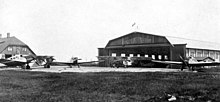Sablatnig P III
| Sablatnig Sab P III | |
|---|---|

|
|
| Type: | Airliner |
| Design country: | |
| Manufacturer: | |
| First flight: |
June 1919 |
| Production time: |
until 1923 |
| Number of pieces: |
about 30 to 40 |
The Sablatnig P III was a German civil aircraft from Sablatnig Flugzeugbau GmbH .
History and construction
The Sab P III was designed as a special airliner by Hans Seehase in 1918 . The rectangular hull of the braced high-decker was a wooden construction and planked with plywood . The wings were covered with fabric. On landing, the Sab P III was braked by means of a grinding spur, as the rigid landing gear was neither braked nor sprung. The aircraft was characterized by low fuel consumption and easy boarding. The folding wings and the tail unit , which allowed rail transport , were technical innovations as well as the possibility of controlling vital equipment by the pilot. This was located in an open cockpit on the fuselage, while a closed, heated cabin with lighting and a mahogany table with an ashtray and an electric cigar lighter was available for the passengers . The on-board mechanic sat behind the pilot to the left. The landing distance of 135 meters and the distance of 165 meters required for take-off made it possible to approach the numerous German commercial airports that had taxiways with lengths of less than 400 meters.
Versions
The passenger seats could be removed with little effort, so that the machine could quickly be converted into a cargo plane. The medical version was designed to transport a person lying down with two companions. There was also a version for aerial photography in which the serial imaging device was installed in the middle of the cabin.
use
From 1919 she was used by Luftverkehr Sablatnig , later Lloyd Luftverkehr Sablatnig , in regular service. Other machines were used by the Deutsche Luft-Reederei and came to Lufthansa from there in 1926 . The machine was flown among others by the Deutsche Luft Hansa as D-143 "Biene", D-171 "Hummel", D-581 "Libelle", D-770 "Mücke", D-984 "Ameise". The decommissioning took place in the 1930s.
Twelve machines built at the Dwigatel wagon factory in Reval in 1922/23 with the registrations “E-1” to “E-12” were used by the Aeronaut airline in Estonia .
Technical specifications
| Parameter | Data |
|---|---|
| crew | 2 (pilot and mechanic) |
| Passengers | Max. 6th |
| length | 8.94 m |
| span | 16.00 m |
| height | 3.25 m |
| Wing area | 47.00 m² |
| Empty mass | 1334 kg |
| Takeoff mass | 2184 kg |
| Payload | 850 kg |
| payload | 450 kg |
| Engine | a Maybach Mb IVa , 6-cylinder in- line engine ; 260 PS (approx. 190 kW) |
| alternative engines |
Benz Bz IV , 200 PS (approx. 150 kW) Armstrong Siddeley Puma , 240 PS (approx. 180 kW) BMW IV , 220 PS (approx. 160 kW) Junkers L 2 , 230 PS (approx. 170 kW) |
| Cruising speed | 150 km / h at sea level |
| Top speed | 170 km / h at sea level |
| Range | 450 km |
See also
literature
- Heinz AF Schmidt: Historic Airplanes II . Transpress VEB publishing house for transport, Berlin 1970
- Wolfgang Wagner: German air traffic . The pioneering years 1919–1925. In: German aviation . 1st edition. tape 11 . Bernard & Graefe Verlag, Koblenz 1987, ISBN 3-7637-5274-9 , p. 258-263 .
Web links
- Technical specifications
- Information on German aviation 1919–1945 (English)
- Page with image of Sab P III ( Memento from October 14, 2007 in the Internet Archive )
- List of historical license plates
Individual evidence
- ^ Karl-Dieter Seifert: The beginnings of German air traffic. In: Fliegerrevue X No. 79, PPV Medien, Bergkirchen 2019, ISSN 2195-1233, p. 26
- ^ Wolfgang Wagner: The German air traffic . The pioneering years 1919–1925. In: German aviation . 1st edition. tape 11 . Bernard & Graefe Verlag, Koblenz 1987, ISBN 3-7637-5274-9 , p. 258-263 .

